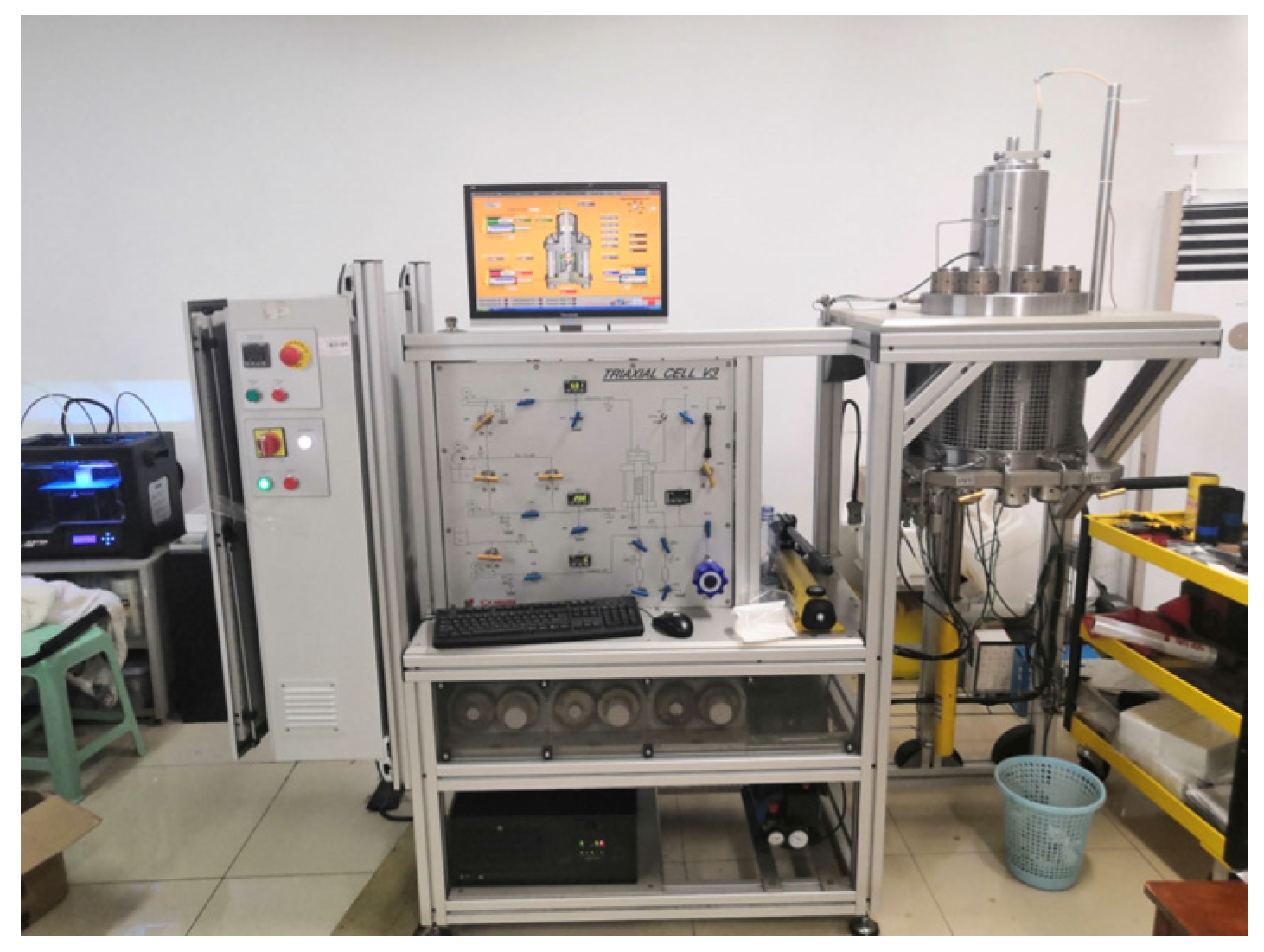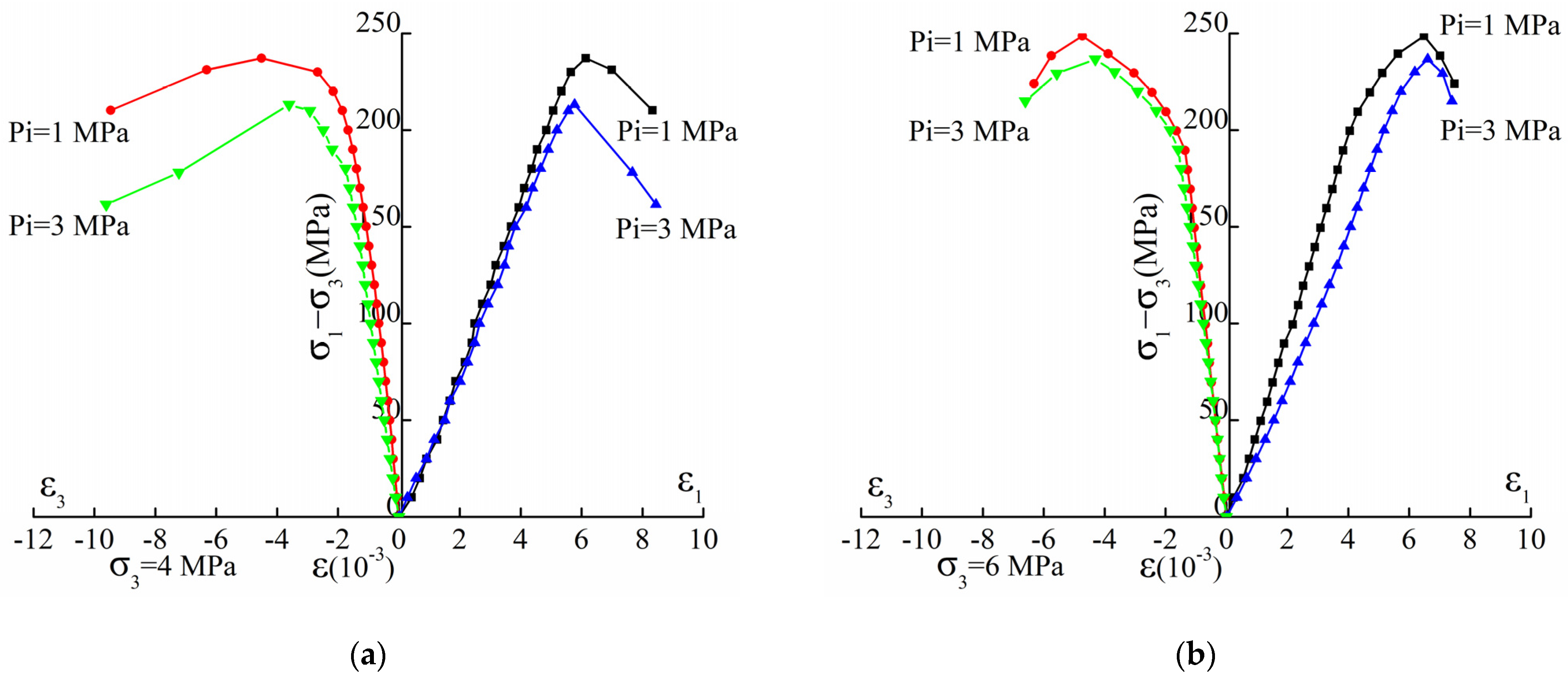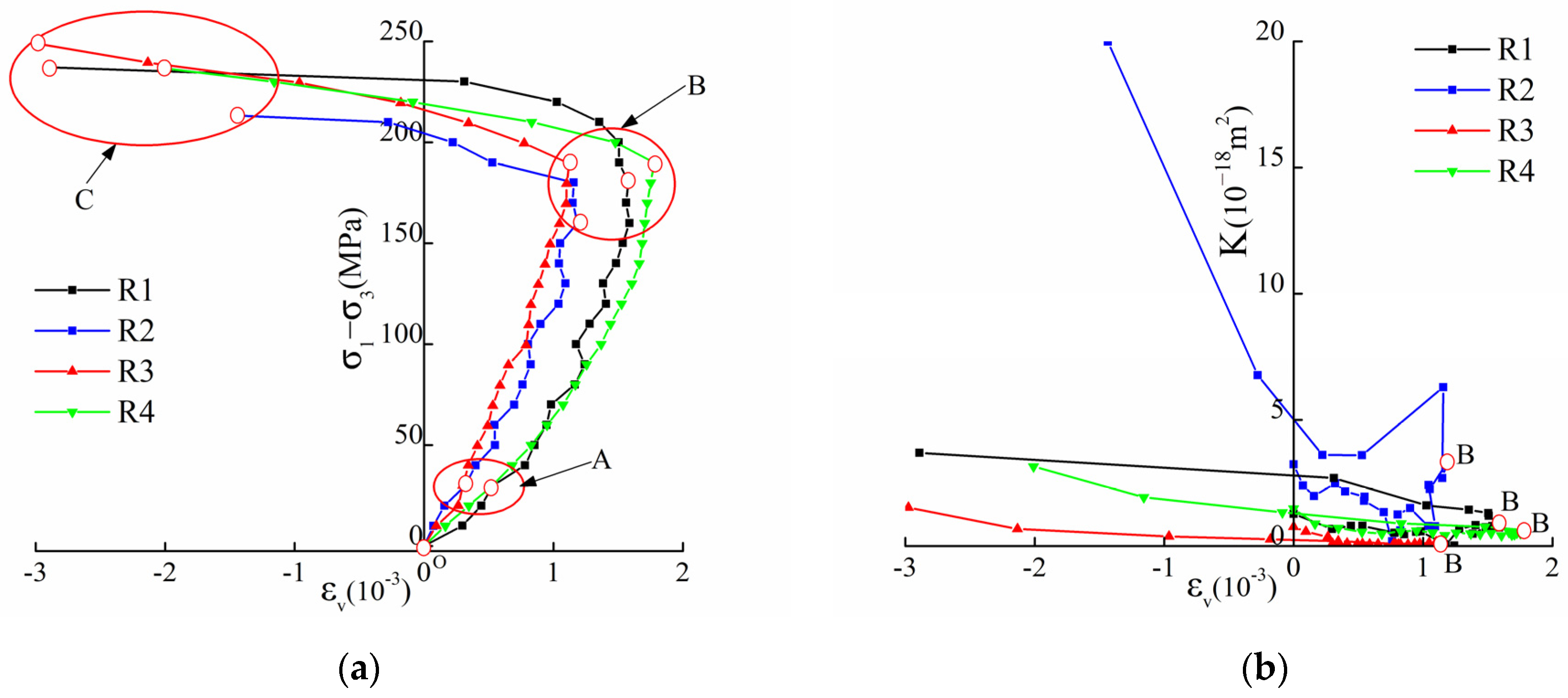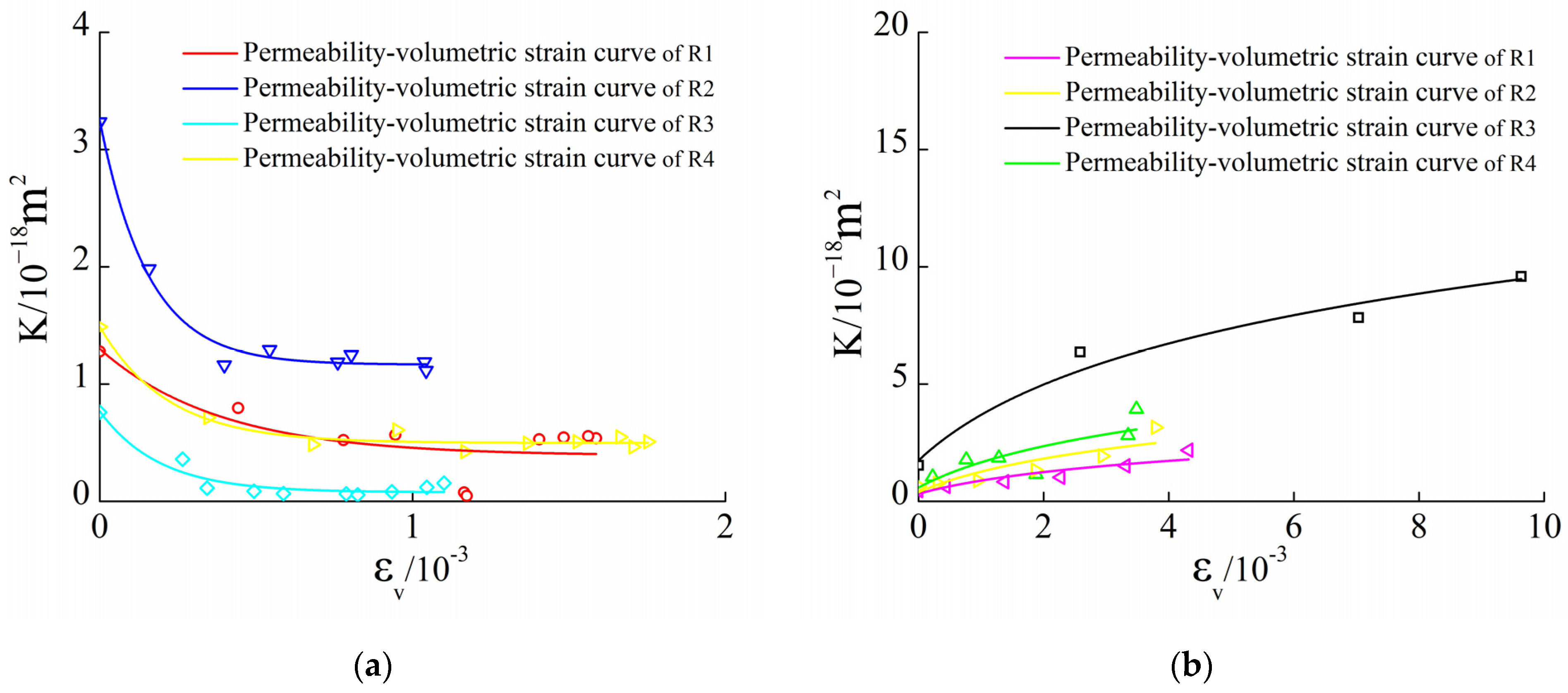Study on Experimental and Constitutive Model of Granite Gneiss under Hydro-Mechanical Properties
Abstract
:1. Introduction
2. Materials and Methods
2.1. Basic Physical Characteristics of Granite Gneiss
2.2. Experiment Plan and Method
3. Results and Discussion
3.1. Stress–Strain Curve under Hydro-Mechanical Properties
3.2. Impact of Seepage Pressure on Deformation and Strength Parameters
3.3. Permeability Evolution Law of Granite Gneiss
4. Numerical Simulation
4.1. Proposal of Coupling Variables
4.2. Establishment of Constitutive Model
4.3. Model Validation
5. Conclusions
- (1)
- The results divide the stress–strain process into three stages to characterize rock materials’ mechanical behavior characteristics under triaxial compression conditions. (i) The microcrack compaction stage is a relatively small nonlinear deformation stage on the rock’s internal microcracks and pores under stress. (ii) The linear elastic deformation stage is mainly affected by the pressure of the rock skeleton. Its linear slope is the rock elastic modulus, which is a vital parameter for characterizing mechanical properties. (iii) The damage and failure stage is a nonlinear plastic deformation stage where cracks expand rapidly.
- (2)
- The boundary point between the first and second stages generally distributes around the first intersection of the stress–strain curve and the permeability–strain curve. The volumetric expansion point is the peak value of volumetric strain, which is the dividing point in the second and third stages, identified from the volume stress–strain curve. The granite gneiss hydro-mechanical properties model can be established by the piecewise fitting curve.
- (3)
- In view of the experimental data, a hydro-mechanical properties constitutive model that is suitable for isotropic porous media was built to model the granite gneiss mechanical behavior under different seepage pressure conditions. To test the model’s reliability, compare the numerical and experimental results. The simulated peak strengths of rock samples R1 to R4 were determined to be 237.56 MPa, 214.48 MPa, 248.91 MPa, and 235.82 MPa, respectively. Compared with the experimental data, all of these were less than 1%. The axial peak strains were 6.38, 6.05, 6.55, and 6.93, respectively. Compared with the experimental data, all of these were less than 5%. The two datasets match well, which proves this model can offer a good representation of the rock behavior prominent distinctions, that is, the plastic deformation, material damage, and hydro-mechanical properties, in different seepage pressure conditions.
Author Contributions
Funding
Institutional Review Board Statement
Informed Consent Statement
Data Availability Statement
Conflicts of Interest
References
- Yang, S.Q.; Huang, Y.H.; Jiao, Y.Y.; Zeng, W.; Yu, Q.L. An experimental study on seepage behavior of sandstone material with different gas pressures. Acta Mech. Sinica 2015, 31, 837–844. [Google Scholar] [CrossRef]
- Jing, L.R.; Feng, X.T. Numerical modeling for coupled thermo-hydro-mechanical and chemical processes (THMC) of geological media-international and Chinese experoences. Chin. J. Rock Mech. Eng. 2003, 22, 1704–1715. [Google Scholar]
- Yin, Q.; Wu, J.Y.; Jiang, Z.; Zhu, C.; Su, H.; Jing, H.; Gu, X. Investigating the effect of water quenching cycles on mechanical behaviors for granites after conventional triaxial compression. Geomech. Geophys. Geo-Energy Geo-Resour. 2022, 8, 77. [Google Scholar] [CrossRef]
- Figueiredo, B.; Tsang, C.F.; Rutqvist, J.; Niemi, A. A study of changes in deep fractured rock permeability due to coupled hydro-mechanical effects. Int. J. Rock Mech. Min. Sci. 2015, 79, 70–85. [Google Scholar] [CrossRef]
- Chen, J.; Zhao, J.; Zhang, S.; Zhang, Y.; Yang, F.; Li, M. An experimental and analytical research on the evolution of mining cracks in deep floor rock mass. Pure Appl. Geophys. 2020, 177, 5325. [Google Scholar] [CrossRef]
- Lin, L.; Xu, W. Experimental Researches on Long-Term Strength of Granite Gneiss. Adv. Mater. Sci. Eng. 2015, 2015, 187616. [Google Scholar]
- Yasuhara, H.; Kinoshita, N.; Ogata, S.; Cheon, D.S.; Kishida, K. Coupled thermo-hydro-mechanical-chemical modeling by incorporating pressure solution for estimating the evolution of rock permeability. Int. J. Rock Mech. Min. Sci. 2016, 86, 104–114. [Google Scholar] [CrossRef]
- Yang, S.Q.; Jing, H.W. Evaluation on strength and deformation behavior of red sandstone under simple and complex loading paths. Eng. Geol. 2013, 164, 1–17. [Google Scholar] [CrossRef]
- Yang, S.Q.; Jing, H.W.; Cheng, L. Influences of pore pressure on short-term and creep mechanical behavior of red sandstone. Eng. Geol. 2014, 179, 10–23. [Google Scholar] [CrossRef]
- Liu, L.; Xu, W.Y.; Wang, H.L.; Wang, W.; Wang, R.B. Experimental studies on hydro-mechanical properties of metamorphic rock under hydraulic pressures. Eur. J. Environ. Civ. Eng. 2016, 20, 45–59. [Google Scholar] [CrossRef]
- Chen, H.Z.; Shao, Z.S.; Jin, D.D.; Zhang, Z.; Zhou, D.B. A numerical investigation into the effect of homogeneity on the time-dependent behavior of brittle rock. Materials 2021, 14, 6818. [Google Scholar] [CrossRef] [PubMed]
- Uchida, S.; Klar, A.; Yamamoto, K. Sand production model in gas hydrate-bearing sediments. Int. J. Rock Mech. Min. Sci. 2016, 86, 303–316. [Google Scholar] [CrossRef]
- Menaceur, H.; Delage, P.; Tang, A.M.; Conil, N. The thermo-mechanical behaviour of the Callovo-Oxfordian claystone. Int. J. Rock Mech. Min. Sci. 2015, 78, 290–303. [Google Scholar] [CrossRef]
- Wang, Z.; Li, S.; Qiao, L.; Zhang, Q. Finite element analysis of the hydro-mechanical behavior of an underground crude oil storage facility in granite subject to cyclic loading during operation. Int. J. Rock Mech. Min. Sci. 2015, 73, 70–81. [Google Scholar] [CrossRef]
- Zhang, Z.L.; Xu, W.Y.; Wang, W.; Wang, R.B. Triaxial creep tests of rock from the compressive zone of dam foundation in Xiangjiaba Hydropower Station. Int. J. Rock Mech. Min. Sci. 2012, 50, 133–139. [Google Scholar] [CrossRef]
- Zhao, J.; Feng, X.T.; Yang, C.; Zhou, Y.; Zhang, Y. Study on time-dependent fracturing behaviour for three different hard rock under high true triaxial stress. Rock Mech. Rock Eng. 2021, 54, 1239–1255. [Google Scholar] [CrossRef]
- Zuo, J.P.; Wei, X.; Wang, J.; Liu, D.J.; Cui, F. Investigation of failure mechanism and model for rocks in deep roadway under stress gradient effect. J. China Univ. Min. Technol. 2018, 47, 478–485. [Google Scholar]
- Liu, L.; Xu, W.Y.; Wang, H.L.; Wang, W.; Wang, R.B. Permeability evolution of granite gneiss during triaxial creep tests. Rock Mech. Rock Eng. 2016, 49, 3455–3462. [Google Scholar] [CrossRef]
- Zhang, Y.; Shao, J.F.; Xu, W.Y.; Zhao, H.B.; Wang, W. Experimental and numerical investigations on strength and de-formation behavior of cataclastic sandstone. Rock Mech. Rock Eng. 2015, 48, 1083–1096. [Google Scholar] [CrossRef]
- Chen, L.; Wang, C.P.; Liu, J.F.; Liu, J.; Wang, J.; Jia, Y.; Shao, J.F. Damage and plastic deformation modeling of beishan granite under compressive stress conditions. Rock Mech. Rock Eng. 2015, 48, 1623–1633. [Google Scholar] [CrossRef]
- Wang, X.; Song, L.; Xia, C.; Han, G.; Zhu, Z. Nonlinear elasto-visco-plastic creep behavior and new creep damage model of dolomitic limestone subjected to cyclic incremental loading and unloading. Sustainability 2023, 13, 12376. [Google Scholar] [CrossRef]
- Yang, S.Q.; Jiang, Y.Z. Triaxial mechanical creep behavior of sandstone. Min. Sci. Technol. 2010, 20, 339–349. [Google Scholar] [CrossRef]
- Hu, B.; Yang, S.; Xu, P. A nonlinear rheological damage model of hard rock. J. Cent. South Univ. 2018, 25, 1665–1677. [Google Scholar] [CrossRef]
- Ulusay, R.; Hudson, J.A. The Complete ISRM Suggested Methods for Rock Characterization, Testing and Monitoring; Springer: Ankara, Turkey, 2007. [Google Scholar]
- Simmons, C.T. Henry Darcy (1803–1858): Immortalised by his scientific legacy. Hydrogeol. J. 2008, 16, 1023–1038. [Google Scholar] [CrossRef]
- Wang, J.A.; Park, H.D. Fluid permeability of sedimentary rocks in a complete stress–strain process. Eng. Geol. 2002, 63, 291–300. [Google Scholar] [CrossRef]
- Zhang, Y.; Liu, Z.B.; Xu, W.Y.; Shao, J.F. Change in the permeability of clastic rock during multi-loading triaxial compressive creep tests. Géotech. Lett. 2015, 5, 167–172. [Google Scholar] [CrossRef]
- Heiland, J. Laboratory testing of coupled hydro-mechanical processes during rock deformation. Hydrogeol. J. 2013, 11, 122–141. [Google Scholar] [CrossRef]
- Palchik, V. Is there link between the type of the volumetric strain curve and elastic constants, porosity, stress and strain characteristics? Rock Mech. Rock Eng. 2013, 46, 315–326. [Google Scholar] [CrossRef]
- Morris, J.P.; Lomov, I.N.; Glenn, L.A. A constitutive model for stress-induced permeability and porosity evolution of Berea sandstone. J. Geophyl. Res. Solid Earth 2003, 108, 237. [Google Scholar] [CrossRef]
- Rubin, M.B.; Vorobiev, O.Y.; Glenn, L.A. Mechanical and numerical modeling of a porous elastic–viscoplastic material with tensile failure. Int. J. Solids Struct. 2000, 37, 1841–1871. [Google Scholar] [CrossRef]
- Liu, L.; Xu, W.Y.; Zhao, L.Y.; Zhu, Q.Z.; Wang, R.B. An experimental and numerical investigation of the mechanical behavior of granite gneiss under compression. Rock Mech. Rock Eng. 2017, 50, 499–506. [Google Scholar] [CrossRef]
- Shao, J.F.; Zhu, Q.Z.; Su, K. Modeling of creep in rock materials in terms of material degradation. Comput. Geotech. 2003, 30, 549–555. [Google Scholar] [CrossRef]
- Shao, J.F.; Chau, K.T.; Feng, X.T. Modeling of anisotropic damage and creep deformation in brittle rocks. Int. J. Rock Mech. Min. Sci. 2006, 43, 582–592. [Google Scholar] [CrossRef]
- Pietruszczak, S.; Jiang, J.; Mirza, F.A. An elastoplastic constitutive model for concrete. Int. J. Solids Struct. 1988, 24, 705–722. [Google Scholar] [CrossRef]
- Mazars, J. A description of micro-and macroscale damage of concrete structures. Eng. Fract. Mech. 1986, 25, 729–737. [Google Scholar] [CrossRef]






| σ3 (MPa) | |||
|---|---|---|---|
| 4 | 6 | ||
| Pore pressure/MPa | 1 | R1 | R3 |
| 3 | R2 | R4 | |
| Rock Sample | σ3/MPa | Pi/MPa | σc/MPa | ε1c/10−3 | ε3c/10−3 | Es/GPa |
|---|---|---|---|---|---|---|
| R1 | 4 | 1 | 237.13 | 6.13 | −4.51 | 44.91 |
| R2 | 3 | 213.22 | 5.77 | −3.60 | 39.24 | |
| R3 | 6 | 1 | 248.76 | 6.49 | −4.73 | 51.02 |
| R4 | 3 | 236.67 | 6.61 | −4.31 | 40.27 |
| Rock Specimen | Fitting Results | ||||
|---|---|---|---|---|---|
| a1 | b1 | c1 | a2 | b2 | |
| R1 | 0.912 | 2.592 | 0.389 | 2.142 | 1.645 |
| R2 | 2.082 | 6.452 | 1.165 | 9.331 | 1.423 |
| R3 | 0.692 | 5.268 | 0.077 | 0.618 | 0.870 |
| R4 | 0.991 | 4.599 | 0.499 | 1.532 | 1.253 |
Disclaimer/Publisher’s Note: The statements, opinions and data contained in all publications are solely those of the individual author(s) and contributor(s) and not of MDPI and/or the editor(s). MDPI and/or the editor(s) disclaim responsibility for any injury to people or property resulting from any ideas, methods, instructions or products referred to in the content. |
© 2023 by the authors. Licensee MDPI, Basel, Switzerland. This article is an open access article distributed under the terms and conditions of the Creative Commons Attribution (CC BY) license (https://creativecommons.org/licenses/by/4.0/).
Share and Cite
Liu, L.; Wen, B. Study on Experimental and Constitutive Model of Granite Gneiss under Hydro-Mechanical Properties. Appl. Sci. 2023, 13, 12130. https://doi.org/10.3390/app132212130
Liu L, Wen B. Study on Experimental and Constitutive Model of Granite Gneiss under Hydro-Mechanical Properties. Applied Sciences. 2023; 13(22):12130. https://doi.org/10.3390/app132212130
Chicago/Turabian StyleLiu, Lin, and Bo Wen. 2023. "Study on Experimental and Constitutive Model of Granite Gneiss under Hydro-Mechanical Properties" Applied Sciences 13, no. 22: 12130. https://doi.org/10.3390/app132212130
APA StyleLiu, L., & Wen, B. (2023). Study on Experimental and Constitutive Model of Granite Gneiss under Hydro-Mechanical Properties. Applied Sciences, 13(22), 12130. https://doi.org/10.3390/app132212130






